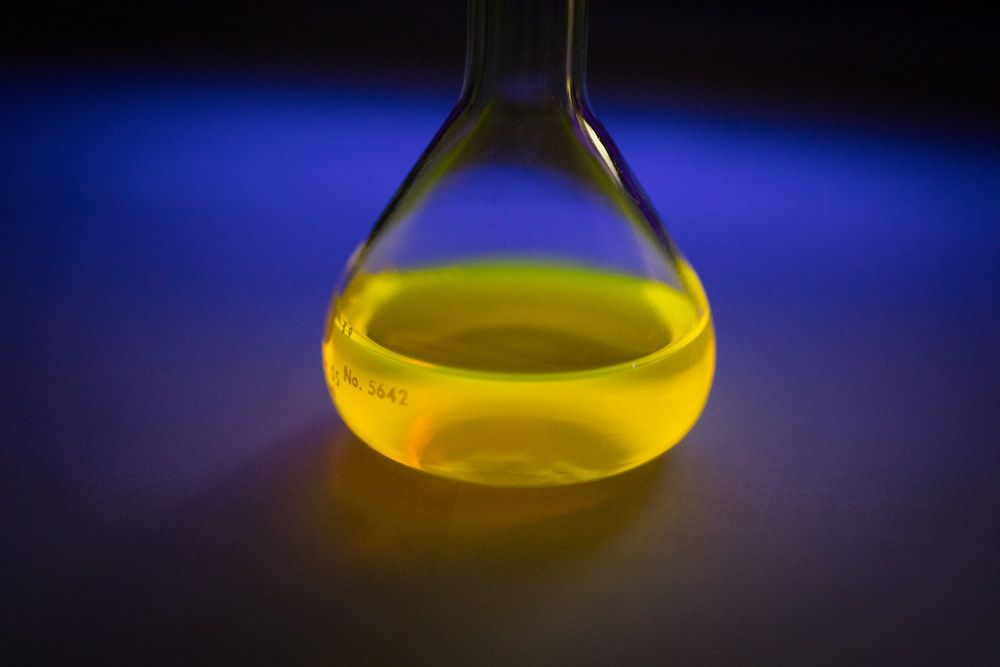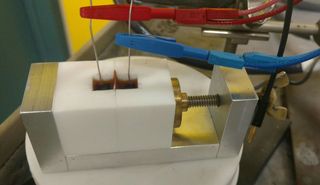
Bright Idea: Glow-in-the-Dark Dye Could Power Cars

If the world one day sees a boom in electric cars and renewable energy, people will need more efficient batteries than are currently available. Now, researchers say a glow-in-the-dark dye used to track chemicals in cells could offer a solution.
The chemical is boron-dipyrromethene, otherwise known as BODIPY, and it consists of a set of carbon rings linked to a boron atom and two fluorine atoms. BODIPY glows under "black" light. Chemistry researchers use it as a marker to see reactions or identify where biological systems take up other substances, such as cadmium.
In the new study, a team of chemists at the University at Buffalo tested BODIPY's power-generating abilities with a special type of battery called a reduction-oxidation battery (or redox). The researchers found that small amounts of the dye added to a solution of acetonitrile could make a battery that can be charged and recharged 100 times without losing its ability to store energy efficiently. [Top 10 Inventions That Changed the World]
In an ordinary rechargeable battery, like the lithium-ion ones used in computers and phones, the changes in the battery chemistry are in a solid state, and it's harder for electrical charges to flow. Lithium-ion batteries use lithium as the charge carrier; lithium gives up electrons and moves from the negative to positive electrode.
Usually a battery has carbon and lithium oxide in it, and both are solids (hence the term "solid state"), so the substance of the battery has to be porous enough for the lithium ions to get through easily. Between the lithium and carbon layer is a liquid electrolyte to carry the charges (it typically isn't water, and the chemical varies among different manufacturers). The problem is that after repeated charge cycles, the electrodes inside the battery can degrade, because they are reacting with the other chemicals in the battery.

Building a better battery
Tim Cook, an assistant professor of chemistry at the University at Buffalo and lead author of the new study, told Live Science that his team combined two different approaches. The first one involved using a redox battery, (redox is short for reduction-oxidation) which consists of two chambers of liquid kept separate by a membrane. In this system, the liquids are the electrolytes surrounding the positive and negative terminals, and with that setup, it's necessary only to find something that will dissolve in the liquid and release electrons.
"If the charge carrier is in solution, it doesn't have the problem other batteries have when [the electrode] crystallizes," which happens with some lithium-ion batteries, Cook said.
Sign up for the Live Science daily newsletter now
Get the world’s most fascinating discoveries delivered straight to your inbox.
The second step was finding a substance that could dissolve in liquid and carry electrons. The researchers found that BODIPY was a very effective electron carrier; it both gives up and takes in electrons easily, Cook said. This means the glow-in-the-dark substance is more efficient at delivering energy.
This redox battery may be a safer option than lithium ion batteries, which sometimes catch fire. This happens because the lithium in them is ionized, meaning it has given up an electron. That makes the element very reactive with the oxygen in water, including the moisture in the air, forming lithium oxide and releasing hydrogen.
"What you're left with is two ionized hydrogens that were attached to water, and we have two lithiums that gave up electrons to join with the water, and that reaction is kicking off a lot of heat too," Cook said.
The hydrogen that can burn if a spark hits it, or the chemicals used for the electrolyte, can react with air. (Lithium itself is so reactive that a popular demonstration in chemistry classes is dropping lithium in water to watch it bubble and generate hydrogen.)
Safer option?
When lithium ion batteries catch fire it's usually because the casing of the battery cracks, exposing the insides to the air, or because the membranes that separate the chemical species inside the battery get damaged, allowing reactions to occur inside the battery. Those reactions generate gases, heat, and sometimes fire. [9 Odd Ways Your Tech Device May Injure You]
"A [lithium]-based battery has a lot of energy, and if there are mechanical failures, like the membrane separator is ruptured, the battery will discharge all at once, creating a tremendous amount of heat," Cook said.
Recently, Samsung issued a recall of its Galaxy Note 7 smartphones because of faulty batteries that, in some cases, were exploding or catching fire. These battery problems could potentially happen in any lithium-ion-dependent battery system, the researchers said.
The liquid in a redox battery is instead stored in tanks, and can be recycled through the volume of the battery. Eventually, even redox batteries degrade, but a fresh liquid supply can allow them to be used again, according to the study.
Here on Earth
Cook said the technology was originally developed at NASA for space probes, but the agency eventually found better battery solutions for spacecraft. However, redox batteries could be useful for more Earthbound applications, the researchers said. And while redox batteries' liquid can oxidize, the acetonitrile that Cook's team used won't burn, the scientists said.
Cook added that it's important to note that his battery tests were done only on tabletop systems, producing just a few volts. But it took only small concentrations of BODIPY to get results, he said. The downside is that redox batteries usually have to be larger because their energy density is smaller, so odds are they will be more useful for storing large amounts of power in homes and cars rather than phones, Cook said.
About 1,320 gallons (5,000 liters) using Cook's current chemical mixture could power a house. That would mean a battery the size of a septic tank for a four-bedroom house. Cook thinks with some work on the concentration of BODIPY, he can get the volume needed down to about 175 gallons (660 liters), about the size of a refrigerator or large fish tank, he said.
Meanwhile the need for efficient batteries in homes may not be so far in the future, if renewable energy keeps making gains. "We didn't really need medium- to large-scale energy storage before," Cook said. "Now, in the last decade, flow batteries [are] becoming [a] popular field of study."
The research was published Nov. 16 issue in the journal ChemSusChem.
Original story on Live Science.













